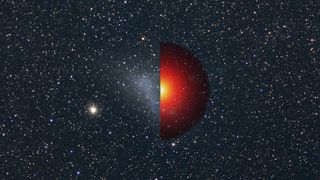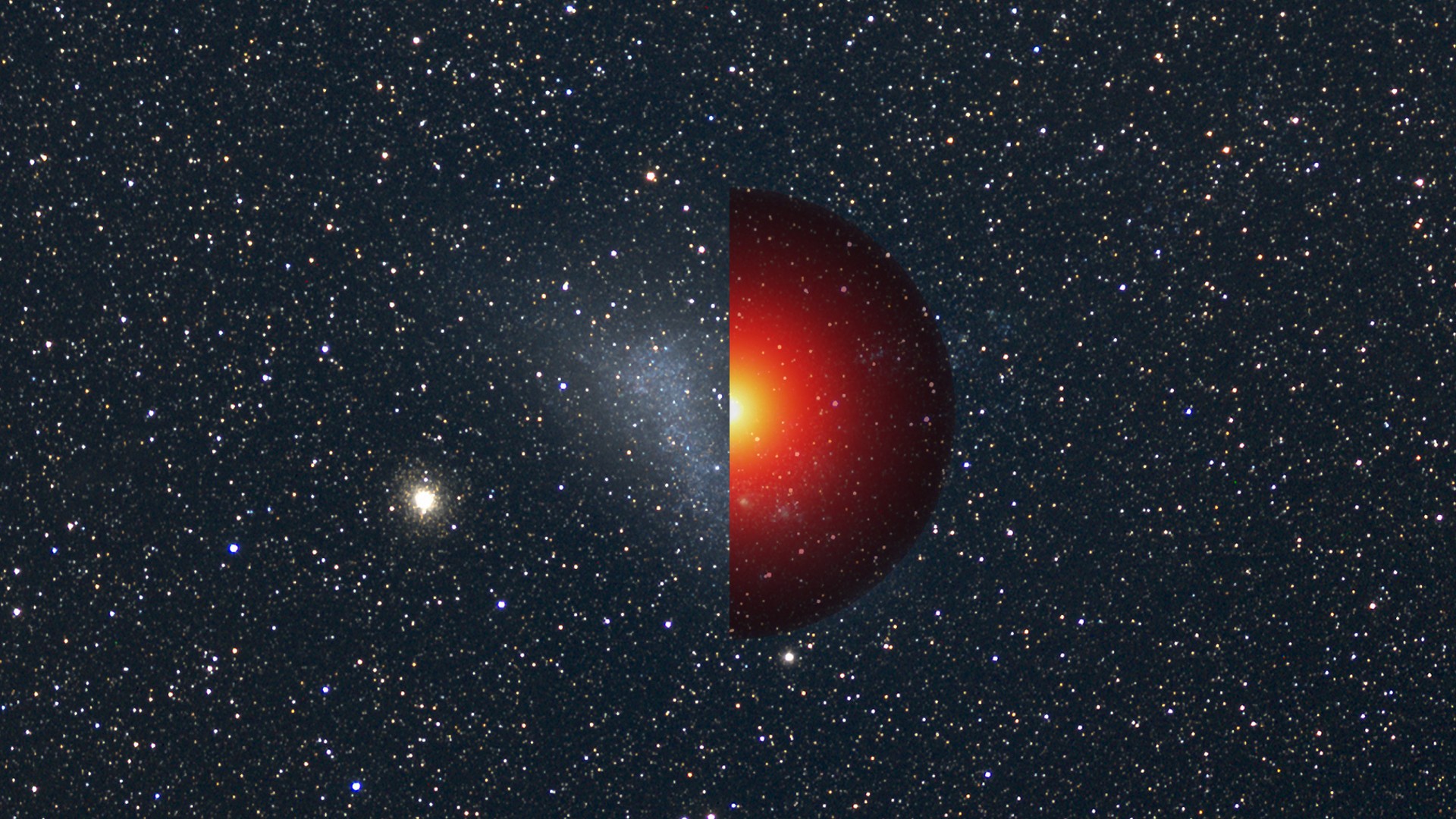
(Image credit: Dark matter, R. Caputo et al. 2016; background, Axel Mellinger, Central Michigan University)
You may not be a fan of dark matter, the hypothetical particle that makes up the bulk of the mass in the universe. And it’s true that the dark matter hypothesis has its shortcomings — and, of course, we haven’t found any dark matter particles yet. But the truth is that the alternatives are much worse.
The universe is full of unexplained mysteries (which is what keeps astronomers and astrophysicists happily employed), and many of those mysteries surround gravity. As we watch stars orbit the centers of their galaxies, we find that they’re moving far too quickly given the amount of visible matter that can keep them in those orbits with its gravity.
Galaxies buzzing around galaxy clusters also move much too quickly given the amount of visible mass in the clusters. Those same clusters bend background light far too much. Even the large structures arose in our universe far too quickly without an additional source of mass.
Related: Should we be so sure dark matter exists?
The best hypothesis scientists have to explain all of these disparate observations is that there is a new kind of particle, known as dark matter, that inhabits the cosmos. This particle would be almost entirely invisible (hence the name), rarely (if ever) interacting with normal matter. This idea isn’t as far-fetched as it seems; neutrinos are particles with exactly these properties. They don’t have enough mass to explain the dark matter, but they do show that such particles can exist.
But the dark matter hypothesis isn’t perfect. Computer simulations of the growth of galaxies suggest that dark-matter-dominated galaxies should have incredibly high densities in their centers. Observations of real galaxies do show higher densities in their cores, but not nearly enough as those simulations predicted. Also, simulations of dark matter evolving in the universe predict that every galaxy should have hundreds of smaller satellites, while observations consistently come up short.
The case for MOND
Given that the dark matter hypothesis isn’t perfect — and that we have no direct evidence for the existence of any candidate particles — it’s worth exploring other options.
One such option was introduced back in the 1970s alongside the original dark matter idea, when astronomer Vera Rubin first discovered the problem of stars moving too quickly inside galaxies. But instead of adding a new ingredient to the universe, the alternative changes the recipe by altering how gravity works at galactic scales. The original idea is called MOND, for “modified Newtonian dynamics,” but the name also applies to the general family of theories descended from that original concept.
With MOND, you pretty much get what’s on the label. At planetary or solar system scales, Newton‘s gravity works just fine (except, of course, where you need the more detailed calculations of gravity provided by general relativity). But once you go big, the usual F=ma we’re familiar with doesn’t quite apply, and the relationship between force and acceleration follows a different rule.
Under MOND, there’s no need for an additional particle to explain the observations — just a slight tweaking of the gravitational force. And because the tweaking of gravity under MOND is explicitly designed to explain the motions of stars within galaxies, it naturally does that very well. The theory also doesn’t suffer from the overproduction of satellites and the extremely high galactic cores of dark matter.
The flawed champion
But MOND is far from perfect. The modifications made to gravity to explain stellar motions have trouble explaining the motions of galaxies within clusters and the lensing of background light. And MOND isn’t a fully relativistic theory (all modern theories of physics must be compatible with special relativity). An update to MOND that is equivalent, called TeVeS, can compete head-to-head with general relativity — and falls far short. Models based on modified gravity have significant trouble explaining the growth of structure in the universe, features of the cosmic microwave background and more — all places where dark matter works quite well.
There is no MOND-like theory that can account for every single observation when it comes to dark matter; all of them fail at least one test. While MOND may still be accurate when it comes to galaxy rotation curves, there are enough observations to tell us that we would still need dark matter to exist in the universe.
No, the dark matter hypothesis isn’t perfect. But then again, no scientific hypothesis is. When evaluating competing hypotheses, scientists can’t just go with their guts, or pick one that sounds cooler or seems simpler. We have to follow the evidence, wherever it leads. In almost 50 years, nobody has come up with a MOND-like theory that can explain the wealth of data we have about the universe. That doesn’t make MOND wrong, but it does make it a far weaker alternative to dark matter.
Learn more by listening to the “Ask a Spaceman” podcast, available on iTunes (opens in new tab) and askaspaceman.com (opens in new tab). Ask your own question on Twitter using #AskASpaceman or by following Paul @PaulMattSutter (opens in new tab) and facebook.com/PaulMattSutter (opens in new tab).
Follow us on Twitter @Spacedotcom or on Facebook.
Join our Space Forums to keep talking space on the latest missions, night sky and more! And if you have a news tip, correction or comment, let us know at: community@space.com.

Paul M. Sutter is an astrophysicist at SUNY Stony Brook and the Flatiron Institute in New York City. Paul received his PhD in Physics from the University of Illinois at Urbana-Champaign in 2011, and spent three years at the Paris Institute of Astrophysics, followed by a research fellowship in Trieste, Italy, His research focuses on many diverse topics, from the emptiest regions of the universe to the earliest moments of the Big Bang to the hunt for the first stars. As an “Agent to the Stars,” Paul has passionately engaged the public in science outreach for several years. He is the host of the popular “Ask a Spaceman!” podcast, author of “Your Place in the Universe” and “How to Die in Space” and he frequently appears on TV — including on The Weather Channel, for which he serves as Official Space Specialist.
